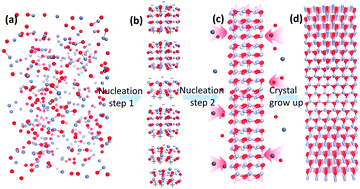Super-long ZnO nanofibers and novel nucleation mechanism for a gas-phase environment: spatial linear nucleation
Abstract
Single-crystal super-long ZnO nanofibers (SZFs) have been prepared via a purposely designed vapor transport process. To understand the growth process, a novel freestanding crystal nucleation mechanism, spatial linear nucleation (SLN), is proposed. The contrast experiments show that the SLN process and crystal growth rate are faster than that of classical mechanisms due to the higher gas supersaturation condition and proper Zn/O ratio. We also find that, for freestanding nucleation, Zn-rich conditions facilitate spatial dot nucleation to form tetrapod-shaped ZnO (T-ZnO), however, O-rich conditions favor SLN and nanofiber growth when the concentration of the reactants is high enough. The SLN process depends strongly on factors such as an ultra-high reactant concentration and an appropriate reactant ratio and temperature. For further proving the validity of the SLN mechanism, molecular dynamics (MD) and geometry optimization (GO) calculations based on first principles were carried out. The results of the calculations demonstrate that the spontaneous oriented attachment of metastable primary nuclei in gas-phase environments is feasible to realize spatial linear nucleation.



 Please wait while we load your content...
Please wait while we load your content...